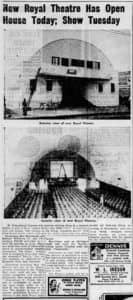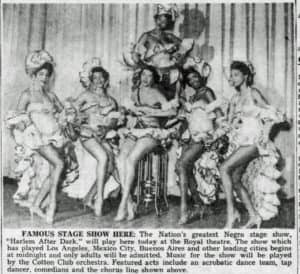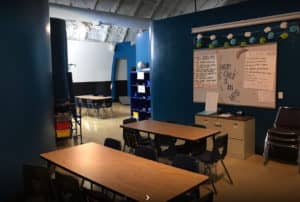Vintage St. Pete: The Royal Theatre
 This story appears in Vintage St. Pete Volume II: Legends, Locations, Lifestyles, from St. Petersburg Press.
This story appears in Vintage St. Pete Volume II: Legends, Locations, Lifestyles, from St. Petersburg Press.
The Royal Theatre opened on Nov. 23, 1948, just a few blocks south of the Manhattan Casino, then the epicenter of nightlife in St. Petersburg’s predominantly African American neighborhood.
A few blocks south, and a million miles away.
While the Manhattan Casino stayed open late for dancing, juking and jiving to the latest sounds from rhythm ‘n’ blues, jazz and swing stars, the Royal was for families, the first – and to date only – movie theater in the area the locals lovingly called “The Deuces.”

The Royal Theatre staff on Opening Night, Nov. 23, 1948. Co-owners Bill Boardman and Horace Williams at left. St. Petersburg Museum of History.
Bill Boardman, the (white) businessman who co-owned the Royal, also owned the Playhouse Theatre on Central Avenue. He boasted that the Royal, an 3,500-square-foot Quonset Hut that cost him $75,000, was a “junior Radio City Music Hall” with 700 seats including two rows of extra-wide seats to accommodate larger clientele.
The new movie house had enormous, air-circulating ceiling fans, which gave it a significant edge over the Harlem Theatre, which had been at 3rd Avenue and 10th Street S. since 1927.
These were the so-called “Black” theatres in those segregated times. St. Petersburg’s half-dozen other movie theaters, including the Playhouse, were – in theory, at least – for white patrons only.
It would be 1964 before the St. Petersburg Times, in its daily “Theatre Time Clock,” discontinued the separate “Negro Theatres” designation.
A family affair
 “The Royal Theatre was one of the primary places where the entire Black community could come together and congregate, and be like a family with each other, and be entertained together,” says Sevell Brown, a St. Petersburg native, longtime Civil Rights activist and National Director of the National Christian League of Councils.
“The Royal Theatre was one of the primary places where the entire Black community could come together and congregate, and be like a family with each other, and be entertained together,” says Sevell Brown, a St. Petersburg native, longtime Civil Rights activist and National Director of the National Christian League of Councils.
The Royal, Brown explains, was “in the neighborhood” for residents of the Jordan Park and Wildwood areas. “The Harlem was on the north side,” he says, “for those who lived in the original Black settlement of Methodist Town.” Folks who lived around 22nd Street rarely ventured up to the Harlem. For parents, he says, the Royal was within the “comfort zone” of safe places to send the kids.
“Everybody will tell you,” Brown continues, “from the dotting of the I to the crossing of the T, that the specialness about the Royal Theatre was that everybody enjoyed being in there watching the movie. It was like a family affair. Where everybody was acting like they were cousins, or whatever it is in terms of family relationships.
“It was everybody sitting there, and guess what? They talked through the whole movie.”
Richard Lawton, who stood six-foot-four, manned the front door and also patrolled the aisles as the movie played, shining his flashlight in the faces of potential troublemakers. “Gimme the noise,” he’d say.
“And that’s how everybody knew about Richard and his entire family,” Brown laughs. “By virtue of the Royal Theatre.”
A much-needed project
The Sons of the Legion Drum and Bugle Corps, 60 members strong, marched down 22nd Street and proceeded to play on the Royal’s front steps for the Grand Opening celebration.
Admission to the first film, a Rod Cameron Western called Panhandle, was 40 cents for adults and 14 cents for children.

1949.
“This is a much-needed project,” observed John D. Brown, a Gibbs High School teacher who attended the Royal’s opening celebration. “We’ve been looking forward to it for the last 10 years.”
Observed Jordan Elementary principal (Mrs.) M.L. Pierce: “It is the finest theatre for colored people I have seen, and to help keep it that way, we are going to start a course at the school to teach the children how to act in public places.”
The features, always first-run, changed two or three times per week in the 1940s and ‘50s; it wasn’t until 1962 that Boardman began running movies for a week – or more – at a time.
Manhattan Casino entertainers, including Roy Brown, the Ink Spots and trumpeter Cootie Williams, sometimes picked up an extra gig performing next afternoon or early evening on the stage of the Royal. The room was also used for community fashion shows and talent contests.
“At the Wednesday night talent show, you had so much talent … a place where up you were lauded and applauded,” Brown remembers. “The talent shows began around 7 or 7:30, and you had to show up two or three hours early to audition to be on the show.”
Sevell Brown never tried to showcase his own singing talent. “I can’t carry a note,” he confesses.
“But everybody that I knew and grew up with, and went to school with, these people would be singing all of the great balladeers. They had voices – and the competition was stiff.”
Members of the Manhattan Casino house bands, professional musicians, would back the young hopefuls at the Royal.
Goldie Thompson, who promoted a series of gospel music shows at the Manhattan Casino, was also a well-liked DJ on WHBO. During his Gaddin’ With Goldie program, he offered 10 free passes to the Royal during a “Name That Tune” promotion in 1951: The mystery music would be played after each Royal commercial; because the movie being promoted was Go For Broke!, a war picture starring Van Johnson, the songs were military marches.
The Young Matrons Non-Pariel Club presented a three-act play, Time For Romance, that same year.

1954.
Boardman gave out free passes to anyone accepting the local CeeJays group’s offer of a free X-ray while a portable unit was in the area. You could also get in free with a bottle cap from Royal Crown Cola.
Saturdays were always packed, especially during the summer months.
Every December, the City of St. Petersburg threw Christmas parties for employees: White employees and their families celebrated at the Florida Theatre at 5th Street North, while Black families welcomed the holidays at the Royal. Both theaters screened Miracle on 34th Street.

1963.
A famous Western film star, Lash LaRue, will appear in a big Hollywood revue today at the Royal Theatre. This marks the first time a Hollywood star has appeared in person at a Negro theatre here. Bill Boardman, Royal manager, said the stage show will be accompanied by LaRue’s latest movie, “Frontier Phantom.” The film features Fuzzy Knight as co-star.
St. Petersburg Times/Feb. 11, 1954
Changes all around
“In the new Jordan Park project and the old Jordan Park project, and in the Wildwood area, we didn’t have air conditioners back then,” Brown recalls. “So when everybody entered the Royal Theatre, everybody just laid back and relaxed in third heaven because they had those big giant fans. They circulated the air so well that you felt like you were in an air-conditioned building.
“You felt like you were down at Webb’s City.”
Ironically, the Civil Rights Movement and the dawn of desegregation spelled the end of the Royal Theatre, as Black citizens began to feel more comfortable outside of their longtime neighborhoods. Mom and Pops suffered; one Black business after another shuttered.
The Harlem Theatre closed and was demolished in 1964; citing decreasing business, and after a rash of petty burglaries, Boardman boarded up the Royal in the final months of ’65, and sold it the following year. He continued to operate the Playhouse as it transitioned into live burlesque and, in time, adult movies.
Meanwhile, formerly “white” movie houses like the Florida and the State began to attract more and move Black attendees. The arrival in 1967 of the twin-screen Plaza, on 1st Avenue S., added additional competition. A six-screen multiplex was added to Tyrone Square Mall in 1972.
The old Royal Theatre, long an abandoned motion picture house and lately a neighborhood eyesore, is taking on a new look. For months, work has been underway to remodel and refurbish the delipidated building. When the rehabilitation is complete, the South Side Boys’ Club will make its home there.
St. Petersburg Times/March 9, 1975

The Quonset Hut interior today. Image: Google Maps.
The Royal was added to the St. Petersburg Register of Historic Places in 2001. Following a major overhaul, the Boys and Girls Clubs of the Suncoast added dance and art studios, classrooms and a $225,000 a recording studio bankrolled by local businessman Bill Edwards.
The Royal remains an important part of the Deuces neighborhood.
“Boys & Girls Clubs of the Suncoast’s Royal Theater Club has been honored to serve our local kids and community since 1975, providing out of school time programs that support children as they grow and develop,” says the organization’s President and CEO Freddy Williams.
“Our programs provide access to educational opportunities, with exposure to the arts through our innovative podcast program and recording studio. South St. Pete has been an integral part of our Club history, and allowed us to support thousands of remarkable kids and teens throughout the years.”

The Gibbs High School Mural Club, with JBM Studios, painted the north side of the Royal’s Quonset Hut for the 2019 SHINE Mural Festival. Photo: Edel Mohr.








Stanley Butler
July 29, 2021at11:35 am
Thanks for bringing the aspect back to collared section
Carl Lavender
July 29, 2021at8:15 am
Bill. You’re the very best. Royal history is so important. Thanks.
Charlie Guy
July 28, 2021at3:57 pm
Bill…thanks for your fantastic historical vignettes demonstrating the “HOW & WHY” this area has been SO very important for SO many families for SO many years! While a resident for only the past 20 years, I have learned that this is a very proud community that does NOT want wait again for the “possible promised benefits” in a future development of the Tropicana Field to finally reach them. Both the 2 RFP finalists foresee only in their “later phases” of the early to mid 2030’s to begin their “connection” activities.
Your historic vignettes also very clearly amplify why it is so very import that the City continue its support of the self-initiated Warehouse Arts District/Deuces Live Joint Action Plan by utilizing a very significant portion of its $45 million in American Rescue Plan Act funds to accelerate their dreams….NOW!
What a wonderful and very dramatic way for Mayor Kriseman and all the City Council members of the nearly past 8 years to NOW create their historic legacy by accelerating this escape from this historical community’s very “challenging past”!!
Charlie Guy, Co-Founder, Southside Greenway
Scott Simmons
July 28, 2021at1:58 am
Thanks Bill for another piece of history. Well done. You are doing tremendous work.
KAREN J. DOUGLAS
July 27, 2021at7:48 pm
What an enjoyable read, nostalgic and full of newsy stuff. Thanks for sharing all the little bits of info that made 22nd and Jordan Park a vital a part of our history.
D J Nicholas
July 27, 2021at12:38 pm
Do you have any info on Sunny Hours School or the Gulf Winds drive-in theater,both located on St Pete Beach?
Bill DeYoung
July 27, 2021at3:06 pm
Sunny Hours is on the short list of future Vintage stories!